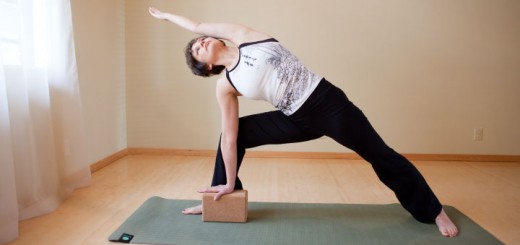How to set long-term goals for your work with yoga students
4When we work with yoga students one-on-one, we always begin by identifying each student’s unique needs. The first question we always ask our new yoga students is, “What do you hope to get out of this?” Helping students articulate their desires and goals is essential for yoga teachers and therapists because it defines the direction of their work and choice of strategies, and it’s essential for students because it helps narrow their focus and set their expectations.
I believe it was T.K.V. Desikachar who said, “Give your students 80% of what they want and 20% of what they need,” i.e., we should always prioritize what the students think they need, but also include some of what we think would benefit them. For example, you might have a session with a new student who is interested in relieving her hip pain. During your session, you might notice her tendency to clench her shoulders, hold her breath, and move from one thing to the next without any pause or rest in between. While none of these things is causing her hip pain, they might be relevant because they illustrate how she holds her body and lives her life in general. This is why, as you work on her articulated issue of hip tension, you can also include some movement, breathing, and awareness practices that address other underlying challenges you observe. But don’t get distracted from the student’s priorities by your own agenda. It’s also helpful to explain to the student briefly why you choose to work on these additional factors and how they might contribute to the student’s current challenges.
In clinical environments, health practitioners are usually required to set goals during the initial evaluation and formulate them in functional, measurable, observable, and action-oriented terms. These goals also must be realistic for the client, appropriate for the practice setting, and achievable in a reasonable amount of time. Goals need to reflect the specific functional outcome that the client hopes to gain.
In yoga therapy, we deal with both obvious and subtle layers of the human system, and sometimes the goals we set with our students are measurable (e.g., able to walk for 30 minutes without knee pain) or unmeasurable (e.g., improve the connection between breath and movement). Ultimately, goal setting is important because it helps our students (and ourselves) envision what success would look like in practical measurable terms. Success might look very different for different students, even if they initially set the same goals. For example, several students might identify their goal as “I want to feel stronger.” For one student, this means being able to lift her toddler grandson. For another student, it might mean being able to eat common foods without having an immediate digestive reaction. For somebody else, it might mean being able to carry on a 30-minute conversation with her estranged critical sister without an emotional breakdown.

Clarifying goals and getting specific about desirable outcomes allow our students to focus, motivating them and mobilizing their resources (time, energy, attention). When goals are vague and undefined, both the student and teacher end up wandering in the dark without a clear destination in mind. Vague goals make it hard to evaluate progress or have a sense of accomplishment. Students will never be able to reach vague goals, which is why it’s important to formulate goals in measurable, functional terms. For example, “improving breathing capacity” can be redefined as “The student will be able to maintain six-second inhalation and six-second exhalation for 12 breaths without strain.” Or “Improve connection between breath and movement” can be redefined as “The student will perform his 15-minute home yoga practice while synchronizing his breath and movement in each pose.”
Goals usually include a projected time frame within which the goal is expected to be accomplished. Some goals might take two weeks, while others might take six months. For yoga therapists, it makes sense to set time frames for the duration of students’ purchased session packages. For example, if the student purchased a six-session package and is expected to attend private sessions once a week, it makes sense to set goals for six weeks. If the student is committed to continuous, ongoing yoga sessions, you can set six-month goals, then establish monthly benchmarks to measure progress toward the semiannual goals.
To make it easier to formulate functional goals, we can adapt the COAST goal format used by occupational therapists and turn it into the CAST format for yoga therapists.
C – Client – The client will perform …
A – Action or Accomplishment – What will the client be able to do?
S – Specific conditions – Under what conditions?
T – Timeline – By when?
CAST examples
C–Client will be able to
A–play tennis
S–for 60 minutes without right hip discomfort
T–within six weeks
C–Client will be able to
A–go to bed at 10 p.m. and stay asleep for eight hours
S– without nightly awakenings
T–within one month
C–Client will
A–develop a 15-minute daily yoga practice routine to manage her anxiety
S–with an emphasis on gratitude
T–within two weeks
It might be challenging to think of goals in measurable terms at first, considering the subtle levels of the human system that we routinely work with. However, if we don’t set those goals, we have no way of knowing whether or not we meet them. Did we accomplish what we set out to accomplish? How close are we? What kind of progress are we making? Those questions are impossible to answer when the goals are vague. Sometimes all it takes is to reframe your thinking about what the goals might look like. Instead of planning to “fix” a physical pain or a health condition that the student is dealing with, we can think of concrete activities that your work together will enable and empower your students to do.
Next time we will talk about breaking the long-term goals into manageable pieces, called short-term goals or objectives – tune in!
[jetpack_subscription_form]




















Dear Olga, I absolutely love your approach and I grateful to you and look forward to your posts. Thank you.
I was wondering if you could make a comment about vertigo in yoga practice either in a post or to me directly.
Lauren Vines
Very nuanced understanding of goal setting. Thank you for this post. It’s my first time here.
Thank you and welcome to the community!
Most of us have to idea about the goals. House we will work on it… Thanks